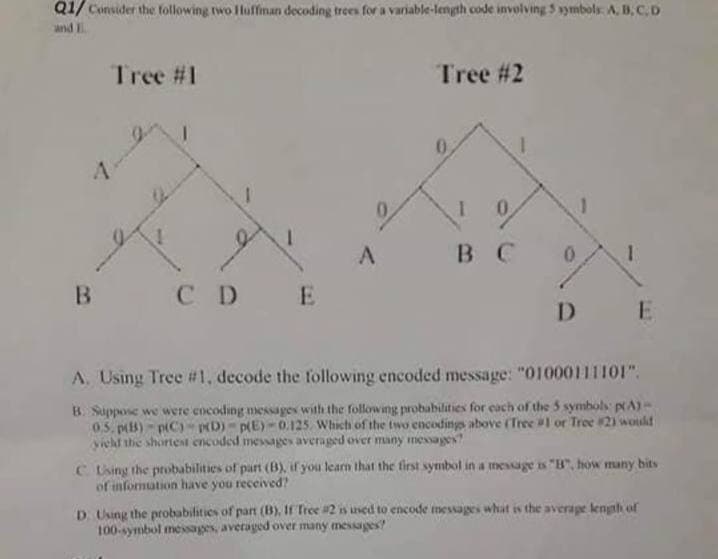Consider the following two Huffiman decoding trees for a variable-length code involving 5 symbols: A, B, C, D and E Tree #1 Tree #2 I 0 A BC 0 1 B CD E D E A. Using Tree #1, decode the following encoded message: "01000111101". B. Suppose we were encoding messages with the following probabilities for each of the 5 symbols (A)- 0,5. p(B)-p(C)-p(D)-p(E)-0.125. Which of the two encodings above (Tree #1 or Tree #2) would yield the shortest encoded messages averaged over many messages? C. Using the probabilities of part (B), if you learn that the first symbol in a message is "B", how many bits of information have you received? 4 0
Consider the following two Huffiman decoding trees for a variable-length code involving 5 symbols: A, B, C, D and E Tree #1 Tree #2 I 0 A BC 0 1 B CD E D E A. Using Tree #1, decode the following encoded message: "01000111101". B. Suppose we were encoding messages with the following probabilities for each of the 5 symbols (A)- 0,5. p(B)-p(C)-p(D)-p(E)-0.125. Which of the two encodings above (Tree #1 or Tree #2) would yield the shortest encoded messages averaged over many messages? C. Using the probabilities of part (B), if you learn that the first symbol in a message is "B", how many bits of information have you received? 4 0
Database System Concepts
7th Edition
ISBN:9780078022159
Author:Abraham Silberschatz Professor, Henry F. Korth, S. Sudarshan
Publisher:Abraham Silberschatz Professor, Henry F. Korth, S. Sudarshan
Chapter1: Introduction
Section: Chapter Questions
Problem 1PE
Related questions
Question

Transcribed Image Text:Q1/ Consider the following two Huffinan decoding trees for a variable-length code involving 5 symbols: A, B, C, D
and I.
Tree #1
Tree #2
1
0
A
BC
1
B
C D
E
DE
A. Using Tree #1, decode the following encoded message: "01000111101".
B. Suppose we were encoding messages with the following probabilities for each of the 5 symbols (A)-
0.5.p(B)-p(C)-p(D)-p(E)-0.125. Which of the two encodings above (Tree #1 or Tree #2) would
yield the shortest encoded messages averaged over many messages?
C. Using the probabilities of part (B), if you learn that the first symbol in a message is "B", how many bits
of information have you received?
D. Using the probabilities of part (B), If Tree #2 is used to encode messages what is the average length of
100-symbol messages, averaged over many messages?
Expert Solution
This question has been solved!
Explore an expertly crafted, step-by-step solution for a thorough understanding of key concepts.
Step by step
Solved in 4 steps

Knowledge Booster
Learn more about
Need a deep-dive on the concept behind this application? Look no further. Learn more about this topic, computer-science and related others by exploring similar questions and additional content below.Recommended textbooks for you

Database System Concepts
Computer Science
ISBN:
9780078022159
Author:
Abraham Silberschatz Professor, Henry F. Korth, S. Sudarshan
Publisher:
McGraw-Hill Education

Starting Out with Python (4th Edition)
Computer Science
ISBN:
9780134444321
Author:
Tony Gaddis
Publisher:
PEARSON

Digital Fundamentals (11th Edition)
Computer Science
ISBN:
9780132737968
Author:
Thomas L. Floyd
Publisher:
PEARSON

Database System Concepts
Computer Science
ISBN:
9780078022159
Author:
Abraham Silberschatz Professor, Henry F. Korth, S. Sudarshan
Publisher:
McGraw-Hill Education

Starting Out with Python (4th Edition)
Computer Science
ISBN:
9780134444321
Author:
Tony Gaddis
Publisher:
PEARSON

Digital Fundamentals (11th Edition)
Computer Science
ISBN:
9780132737968
Author:
Thomas L. Floyd
Publisher:
PEARSON

C How to Program (8th Edition)
Computer Science
ISBN:
9780133976892
Author:
Paul J. Deitel, Harvey Deitel
Publisher:
PEARSON

Database Systems: Design, Implementation, & Manag…
Computer Science
ISBN:
9781337627900
Author:
Carlos Coronel, Steven Morris
Publisher:
Cengage Learning

Programmable Logic Controllers
Computer Science
ISBN:
9780073373843
Author:
Frank D. Petruzella
Publisher:
McGraw-Hill Education